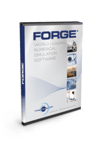 FORGE® ALL-INCLUSIVE is the most complete offer that gives access to ALL features and ALL functionalities included in FORGE® software without any restrictions. It is designed for process engineers, specialists and researchers who are involved in a very large variety of forming processes and willing to make advanced studies
FORGE® ALL-INCLUSIVE is the most complete offer that gives access to ALL features and ALL functionalities included in FORGE® software without any restrictions. It is designed for process engineers, specialists and researchers who are involved in a very large variety of forming processes and willing to make advanced studies
What's inside?
☑ Hot forging
☑ Warm forging
☑ Cold forming
☑ Closed-die forging
☑ Hammer forging
☑ Bar shearing
☑ Flash trimming
☑ Preforming (reducer rolling, cross wedge rolling)
☑ Flat/Long product rolling
☑ Open die forging
☑ Ring rolling
☑ Radial axial ring rolling
☑ Flow forming
☑ Induction heating
☑ Electrical upsetting
☑ Heat treatment
☑ Multi-Pass Files
☑ Rigid tooling
☑ Deformable tooling
☑ Die stress analysis (uncoupled approach)
☑ Die stress analysis (fully coupled approach)
☑ Optimization and inverse analysis
☑ Self-coding of user routines
☑ Material database for hot/warm forging
Key Advantages
All options included in FORGE® Hot Metal Forming Essential and PREMIUM and additional features concerning cold forming, ring rolling and induction-based processes:
- Ability to combine all simulations within the same computation chain
- Batch manager capability to launch a series of simulations one after the other
- User-friendly interface with dedicated templates for the forging industry
- Access to a wide variety of forging equipment: hydraulic press, crank press, drop hammer, counterblow hammer, etc.
- Fully automatic and highly adaptive mesh generator
- Automatic report generator
- High parallel scalability (efficiency based on multiple computational cores) for optimal CPU time speedup
- A robust FEM solver delivering highly reliable results
- Exhaustive material database with more than 800 materials specifically characterized for hot forming processes
- Full compatibility with JMatPro® material software
- Grain flow representation within the part, thanks to our efficient marking grid technique. Marking grids are used to track and locate sensitive areas such as sheared billet surfaces or centerline segregation. This technique can also be used to detect folds, laps and flow-through defects
- Use of sensors to track material points, follow their displacement and record scalar information (temperature, strain, etc.). Sensors provide an understanding of the origin of an issue detected on the finished forged product
- Access to damage criteria to anticipate inner or surface cracks
- Tooling & Forging equipment analysis: tonnage, abrasion wear, stress and deflection obtained via uncoupled die analysis
- Microstructure analysis to calculate grain size and the recrystallized fraction for a selection of alloy steels and nickel-based alloys
- Extended list of forming processes
- The multi-pass file offers the advantage of simulating all forging process passes in a single calculation
- Deformable dies
- Multi-body and multi-material calculation
- Fully coupled die stress analysis including thermal steady-state computation predicting the number of cycles to failure
- Temperature dependency for the abrasion wear model
- Rolling process simulation based on an incremental or steady-state method
- Automatic optimization (e.g. applicable to yield improvement)
- DOE (Design of Experiment) capability
- Self-coding of user subroutines
- Ability to simulate all cold forming processes
- Complete material database for hot/warm/cold forming processes
- Extended list of process templates (sheet metal forming, thread rolling, etc.)
- Extended list of features (e.g. flow limit diagram curve)
- Ability to simulate a selection of new, attractive processes
- Ring Rolling
- Induction-based processes (induction heating, induction heat treating)
- Electrically assisted processes (e.g. electrical upsetting)
- Ability to simulate heat treatment processes (quenching, annealing/tempering, carburizing, case hardening, induction hardening, etc.)
- User-routine framework to calculate bespoke parameters or constitutive models
Your benefits
➽ Take advantage of a modern, intuitive graphical interface, operating on Windows, for data setup and results analysis.
➽ Model all cold, warm or hot forming processes.
➽ Prevent deformations, wear and tool breakage.
➽ Ensure part health by achieving optimum grain flow.
➽ Track sheared faces, segregated areas and flow-through defects.
➽ Predict areas subject to damage.
➽ Simulate heat treatment processes.
➽ Go further with modelling of induction-based processes.
➽ Model the electrical upsetting process and find the right parameters to obtain optimal preforms for forging.
➽ Study in-depth microstructural evolutions.
➽ Upgrade your research activity by implementing and testing advanced models (friction, damage, material behavior, etc.).
➽ Maximize your raw material savings thanks to automatic optimization.
➽ Benefit from the exclusive coupling between THERCAST® (for metal casting and solidification) and FORGE® software.
➽ Develop designs that go beyond the usual framework of your daily production.
Would you like to receive information about other module offers?





